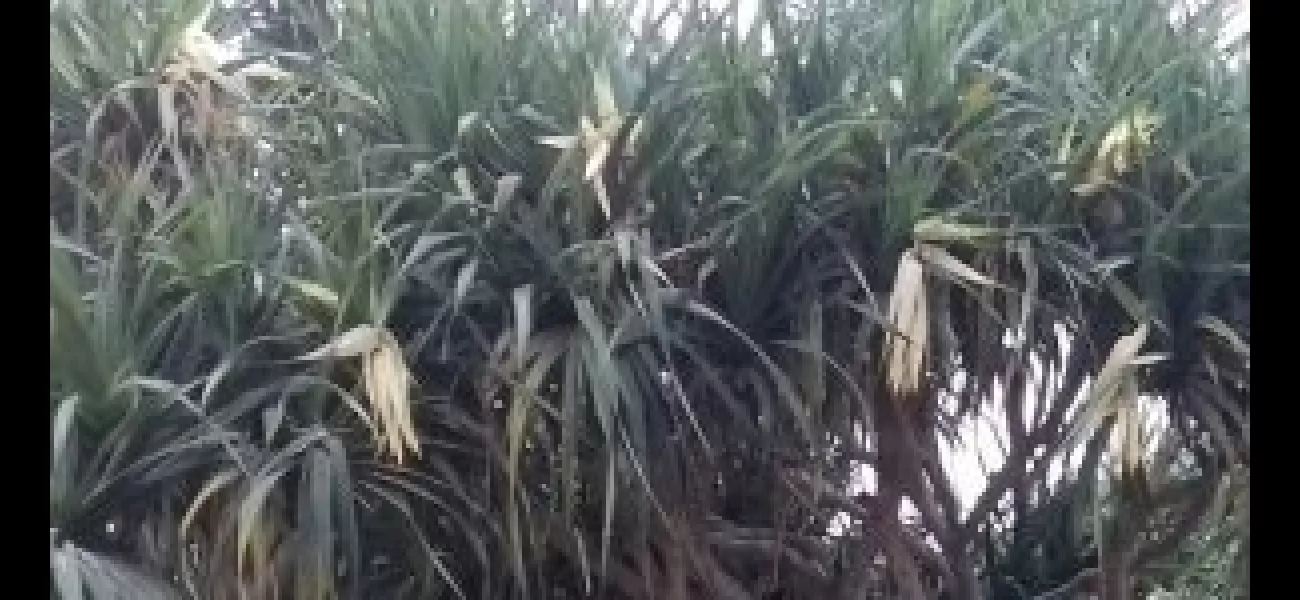The plant kewda plays a vital role in supporting the farmers of Ganjam.
Kewda flower plant is a profitable cash crop for farmers in Ganjam district due to its high concentration in coastal areas and long history of cultivation.
June 12th 2024.

In the beautiful district of Ganjam, located along the coast, there is a special plant that is highly valued by farmers. This plant is known as the Kewda flower plant and it is considered a cash crop for the hardworking and dedicated farmers of this district. The Ganjam district is home to the largest concentration of Kewda forests in the country, making it a prime location for cultivating this special flower.
The Kewda plant has been grown in this area for generations, as it is seen as a valuable asset for the farmers. Not only is the flower itself highly sought after, but other parts of the plant are also commercially exploited in the district. The main blocks where Kewda is grown include Chhatrapur, Chikiti, Rangeilunda, Khallikote, Patrapur, and Kanishi, with many villages such as Kelua Palli, Indrakhi, Tulu, Chandanbadi, Golabandha, Sanapadar, Mananti, Bishwanathpur, and Markandi known for their vast Kewda flower plantations.
The Kewda plant can reach heights of 4-6 metres and is a vital source of income for many farmers in the district, according to Lingraj Sahu, a farmer from Indrakhi village. The plant blooms three times a year, from April to May, July to September, and December to February, and typically starts producing flowers when it reaches 5-7 years of age. As the plant ages, it produces more flowers, with an 18-20-year-old plant producing around 40 flowers, while a plant between 30-40 years old can yield up to 60 flowers.
The Kewda plant thrives in the sandy soil of the coastal areas and once the flowers are collected by harvesters, they are taken to distillation units. The flowers are then processed to extract the precious essence, which is used in various industries such as pan masala, zarda, sherbet, sweets, incense sticks, and medicinal products. The essence is highly sought after and can fetch high prices in the international market, with one litre of Kewda flower essence selling for over Rs4 lakh. Unfortunately, it is reported that the farmers in Ganjam only receive a fraction of this amount, ranging from Rs10,000-15,000 per litre of essence.
Despite these challenges, the Kewda flower trade generates a significant amount of revenue for the district, with an estimated annual income of Rs50-60 crore. This trade also provides employment to around 5 lakh harvesters and involves about 1.5 lakh people. However, the industry has faced setbacks in recent years, with natural disasters like Cyclone Phailin destroying nearly 30% of the Kewda forests in the area. But thanks to efforts to regenerate the forests and training programs to improve the quality of the flowers, the harvesters have found renewed hope and a steady source of income.
In addition to the essence business, some harvesters also make handicraft products from the Kewda leaves, adding to their income. The Odisha University of Agriculture and Technology, along with other research institutions, has pledged to support and provide technical assistance to the Kewda flower harvesters, but there is still room for improvement. Many locals believe that with more government incentives, the harvesters could greatly benefit from their hard work and dedication to this special plant.
The Kewda plant has been grown in this area for generations, as it is seen as a valuable asset for the farmers. Not only is the flower itself highly sought after, but other parts of the plant are also commercially exploited in the district. The main blocks where Kewda is grown include Chhatrapur, Chikiti, Rangeilunda, Khallikote, Patrapur, and Kanishi, with many villages such as Kelua Palli, Indrakhi, Tulu, Chandanbadi, Golabandha, Sanapadar, Mananti, Bishwanathpur, and Markandi known for their vast Kewda flower plantations.
The Kewda plant can reach heights of 4-6 metres and is a vital source of income for many farmers in the district, according to Lingraj Sahu, a farmer from Indrakhi village. The plant blooms three times a year, from April to May, July to September, and December to February, and typically starts producing flowers when it reaches 5-7 years of age. As the plant ages, it produces more flowers, with an 18-20-year-old plant producing around 40 flowers, while a plant between 30-40 years old can yield up to 60 flowers.
The Kewda plant thrives in the sandy soil of the coastal areas and once the flowers are collected by harvesters, they are taken to distillation units. The flowers are then processed to extract the precious essence, which is used in various industries such as pan masala, zarda, sherbet, sweets, incense sticks, and medicinal products. The essence is highly sought after and can fetch high prices in the international market, with one litre of Kewda flower essence selling for over Rs4 lakh. Unfortunately, it is reported that the farmers in Ganjam only receive a fraction of this amount, ranging from Rs10,000-15,000 per litre of essence.
Despite these challenges, the Kewda flower trade generates a significant amount of revenue for the district, with an estimated annual income of Rs50-60 crore. This trade also provides employment to around 5 lakh harvesters and involves about 1.5 lakh people. However, the industry has faced setbacks in recent years, with natural disasters like Cyclone Phailin destroying nearly 30% of the Kewda forests in the area. But thanks to efforts to regenerate the forests and training programs to improve the quality of the flowers, the harvesters have found renewed hope and a steady source of income.
In addition to the essence business, some harvesters also make handicraft products from the Kewda leaves, adding to their income. The Odisha University of Agriculture and Technology, along with other research institutions, has pledged to support and provide technical assistance to the Kewda flower harvesters, but there is still room for improvement. Many locals believe that with more government incentives, the harvesters could greatly benefit from their hard work and dedication to this special plant.
[This article has been trending online recently and has been generated with AI. Your feed is customized.]
[Generative AI is experimental.]
0
0
Submit Comment





